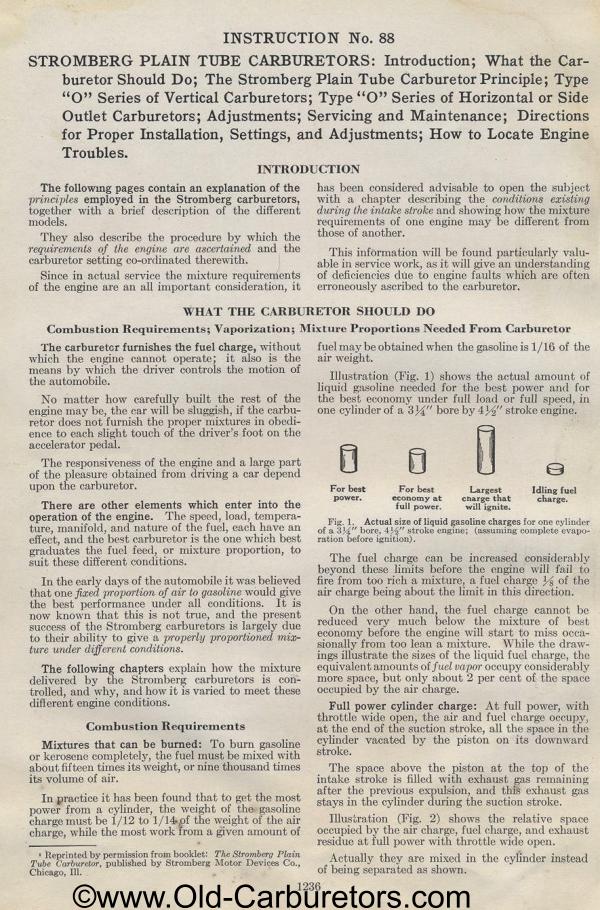STROMBERG PLAIN TUBE CARBURETORS:
Introduction; What the Carburetor
Should Do; The Stromberg Plain Tube Carburetor Principle; Type "0" Series
of Vertical Carburetors; Type "0" Series of Horizontal
or Side Outlet Carburetors; Adjustments; Servicing and Maintenance;
Directions for Proper Installation, Settings, and Adjustments;
How to Locate Engine Troubles.
INTRODUCTION
The following pages contain an explanation of the principles employed
in the Stromberg carburetors, together with a brief description
of the different models.
They also describe the procedure by which the requirements of the
engine are ascertained and the carburetor setting co-ordinated
therewith.
Since in actual service the mixture requirements of the engine
are an all important consideration, ithas been considered advisable
to open the subject with a chapter describing the conditions existing
during the intake stroke and showing how the mixture requirements
of one engine may be different from those of another.
This information will be found particularly valuable in service
work, as it will give an understanding of deficiencies due to engine
faults which are often erroneously ascribed to the carburetor.
WHAT THE CARBURETOR SHOULD DO
Combustion Requirements; Vaporization; Mixture Proportions Needed
From Carburetor
The carburetcr furnishes the fuel charge, without which the engine
cannot operate; it also is the means by which the driver controls
the motion of the automobile.
No matter how carefully built the rest of the engine may be, the
car will be sluggish, if the carburetor does not furnish the proper
mixtures in obedience to each slight touch of the driver's foot
on the accelerator pedal.
The responsiveness of the engine and a large part of the pleasure
obtained from driving a car depend upon the carburetor.
There are other elements which enter into the operation of the
engine. The speed, load, temperature, manifold, and nature of the
fuel, each have an effect, and the best carburetor is the one which
best graduates the fuel feed, or mixture proportion, to suit these
different conditions.
In the early days of the automobile it was believed that one fixed
proportion of air to gasoline would give the best performance under
all conditions. It is now known that this is not true, and the
present success of the Stromberg carburetors is largely due to
their ability to give a properly proportioned mixture under different
conditions.
The following chapters explain how the mixture delivered by the
Stromberg carburetors is con-trolled, and why, and how it is varied
to meet these different engine conditions.
Combustion Requirements
Mixtures that can be burned: To burn gasoline or kerosene completely,
the fuel must be mixed with about fifteen times its weight, or
nine thousand times its volume of air.
In practice it has been found that to get the most power from a
cylinder, the weight of the gasoline charge must be 1/12 to 1/14
pf the weight of the air charge, while the most work from a given
amount of fuel may be obtained when the gasoline is 1/16 of the air
weight.
Illustration (Fig. 1) shows the actual amount of liquid gasoline
needed for the best power and for the best economy under full load
or full speed, in one cylinder of a 3%" bore by 4 " stroke
engine.
For best For best Largest Idling fuel
power, economy at charge that charge.
full power. will ignite.
Fig. 1. Actual size of liquid gasoline charges for one cylinder
of a 3)i" bore, 4%" stroke engine; (assuming complete
evaporation before ignition).
The fuel charge can be increased considerably beyond these limits
before the engine will fail to fire from too rich a mixture, a
fuel charge of the air charge being about the limit in this direction.
On the other hand, the fuel charge cannot be reduced very much
below the mixture of best economy before the engine will start
to miss occasionally from too lean a mixture. While the drawings
illustrate the sizes of the liquid fuel charge, the equivalent
amounts of fuel vapor occupy considerably more space, but only
about 2 per cent of the space occupied by the air charge.
Full power cylinder charge: At full power, with throttle wide open,
the air and fuel charge occupy, at the end of the suction stroke,
all the space in the cylinder vacated by the piston on its downward
stroke.
The space above the piston at the top of the intake stroke is filled
with exhaust gas remaining after the previous expulsion, and this
exhaust gas stays in the cylinder during the suction stroke.
Illustration (Fig. 2) shows the relative space occupied by the
air charge, fuel charge, and exhaust residue at full power with
throttle wide open.
Actually they are mixed in the cylinder instead of being separated
as shown.
Previous page 1927
Supplement Home Next page 
|
